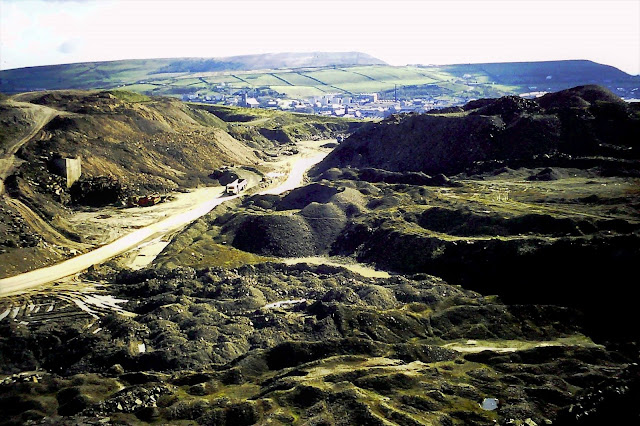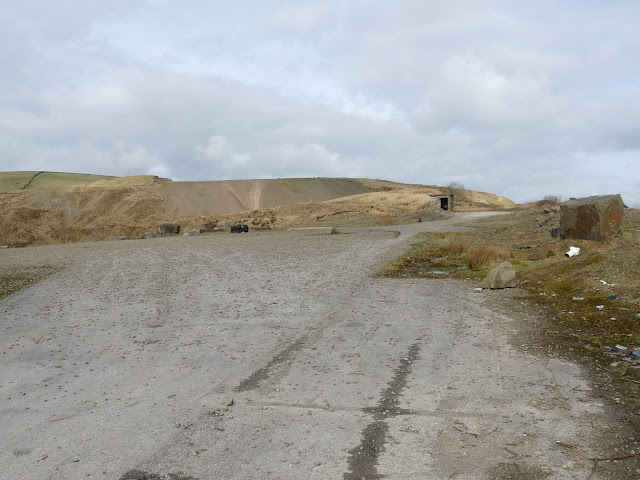Hutch Bank and it's Communities
We have some fabulous photo' showing the quarry when it first opened, then we also have a few more which I took back in 2009 when the quarry was not working. The quarry did open up again for production during the 1980s ? but soon closed again. One of the main interest already shown was the whereabouts of the tunnel or was it tunnels? I think our map can now confirm the one tunnel but in two parts.
I can remember walking through the tunnels back in the late 1950s, they were completely open with no restrictions, they were built on a slow bend, the entrance showed typical stone archways, yet plenty of overburden above them. It was fairly dark inside but there were shafts of light given off by the entrances, there was water constantly dripping on your head. It was clear to see there was railway lines beneath ones feet and of a small narrow guage, which obviously meant that a small train or even the use of manual four wheel bogies must have been used along the tracks. I would imagine that this set up could well have been present from back to the quarry origins.
Thanks to our facebook pages and its readers we are now aware that the tunnels were still present during the 1980s and possibly 1990s but had during this time been gated and locked and probably used for storage of possible explosives and other quarry equipment.
This is a great early photo showing the quarry from its early days
Photo: Edna Kirby collection
Photo: J. Maynard Tomlinson.
Cob Castle Road and its Community
(Above) this was one of the houses at the top of Cob Castle Road long before falling into ruins.
These are the ruins of the Cob Castle houses and how it looks today
(above) This is the Cob Castle Road which lead to the small community
(below) Underbank and its Community
Hutch Bank Farm and its hamlet Community
Not much left these days of the old buildings which lie at the bottom of Hutch Bank
"Hutch Bank Mill"
Hutch Bank Mill (to the forefront - Plantation to the rear)
Woollen processing site established during the first half of
the 18th Century. In 1798 Henry Hargreaves owned the mill which was
described as a water powered carding mill for carding sheep wool.
The mill had various owners during the 1800’s including the
Hutch Bank Manufacturing Company Limited and there was a plan to extend in 1905
which was never carried out.
Production ceased in the 1930’s and the buildings were
cleared towards the end of that decade.
In October 1875 the mill was the scene of a fatal boiler
explosion when 14 year old John Walton who lived at Todd Hall was killed. He
was buried at St James on the 19th October and the cause of death on
his record “Killed by explosion at Flip”
I have just seen your blog about Hutch Bank. I thought you might like this photo of Plantation Mill or Nickys as it was called, the photo was in my grandmother's possession.
Florence Rose is on the right on the back row with her right hand on her sister Sally's shoulder. They had come from Stamford in 1888 with their mother Harriet and lived first at no.1 Underbank where Harriet took in washing for the men on the quarry. They both worked as weavers. Sally married in 1898 and so I've dated the photo to be about this time. According to Gran the lady centre front was in charge of them and was very strict and told them to make sure they looked neat and tidy for the photo but didn't recall what the occasion was.
Harriet and Florence moved to 21 Hutch Bank, where Harriet had a shop and when Florence married Walter Woodburn in 1908 they continued to live there as it was where my mother Rose Woodburn was born in 1910. In 1913 they had moved to 19 Hutch Bank their daughter Doris's birthplace, but in 1915 they had moved to 6 Flip Road where James was born.
1911 Census says Harriet had a sweetshop. I think it was a room in her house, no shop front or anything. Just like Florence did at 6 Flip Road. My mother said she sold sweets, cooked ham and made pies. She also warmed up meals for the factory workers. They brought their meals in the morning and collected them at lunch time from the back door.
Photo: thanks to Chris Kirby
Spring Vale Mill
Shows Carr Parkers (far back left hand) , Waterside (Right hand) and Spring Vale (forefront)
Waterside Mill
Carr Parkers Mill, Charles Lane























































